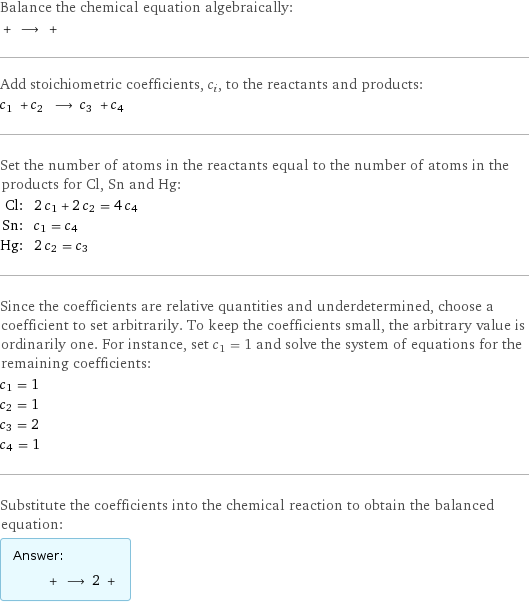Input interpretation

stannous chloride + mercury(I) chloride ⟶ mercury + stannic chloride
Balanced equation

Balance the chemical equation algebraically: + ⟶ + Add stoichiometric coefficients, c_i, to the reactants and products: c_1 + c_2 ⟶ c_3 + c_4 Set the number of atoms in the reactants equal to the number of atoms in the products for Cl, Sn and Hg: Cl: | 2 c_1 + 2 c_2 = 4 c_4 Sn: | c_1 = c_4 Hg: | 2 c_2 = c_3 Since the coefficients are relative quantities and underdetermined, choose a coefficient to set arbitrarily. To keep the coefficients small, the arbitrary value is ordinarily one. For instance, set c_1 = 1 and solve the system of equations for the remaining coefficients: c_1 = 1 c_2 = 1 c_3 = 2 c_4 = 1 Substitute the coefficients into the chemical reaction to obtain the balanced equation: Answer: | | + ⟶ 2 +
Structures

+ ⟶ +
Names

stannous chloride + mercury(I) chloride ⟶ mercury + stannic chloride
Chemical names and formulas

| stannous chloride | mercury(I) chloride | mercury | stannic chloride Hill formula | Cl_2Sn | Cl_2Hg_2 | Hg | Cl_4Sn name | stannous chloride | mercury(I) chloride | mercury | stannic chloride IUPAC name | dichlorotin | chloromercury | mercury | tetrachlorostannane
Substance properties

| stannous chloride | mercury(I) chloride | mercury | stannic chloride molar mass | 189.6 g/mol | 472.08 g/mol | 200.592 g/mol | 260.5 g/mol phase | solid (at STP) | solid (at STP) | liquid (at STP) | liquid (at STP) melting point | 246 °C | 525 °C | -38.87 °C | -33 °C boiling point | 652 °C | 383 °C | 356.6 °C | 114 °C density | 3.354 g/cm^3 | 7.16 g/cm^3 | 13.534 g/cm^3 | 2.226 g/cm^3 solubility in water | | insoluble | slightly soluble | soluble surface tension | | | 0.47 N/m | dynamic viscosity | 7 Pa s (at 25 °C) | | 0.001526 Pa s (at 25 °C) | 5.8×10^-4 Pa s (at 60 °C) odor | odorless | | odorless |
Units
